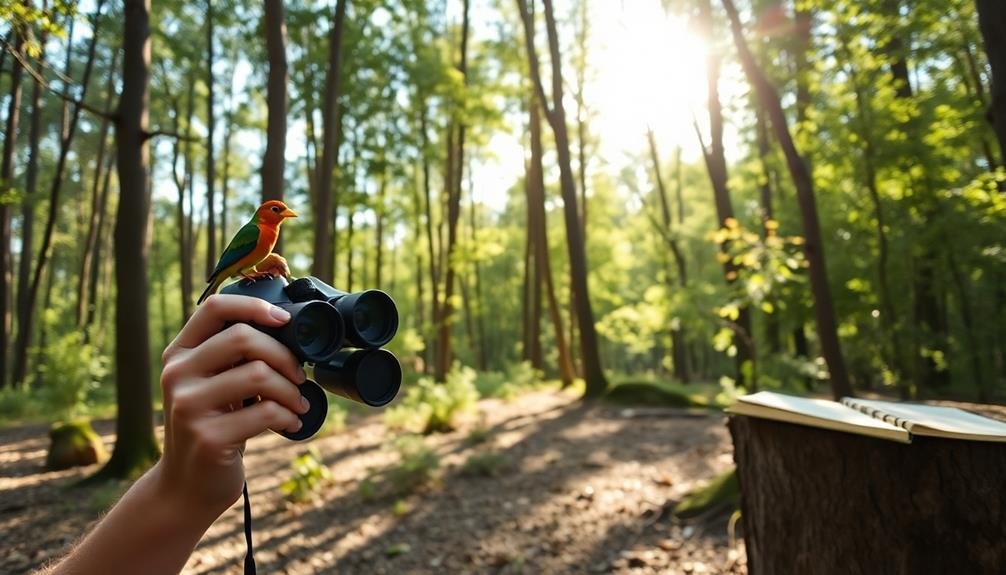Start your bird watching journey by choosing quiet, familiar locations to reduce anxiety. Equip yourself with basic gear like binoculars and a field guide. Learn to identify common local birds through their distinctive features and calls. Practice mindfulness techniques while observing, focusing on your breath and surroundings. Consider joining supportive bird watching groups or online forums for guidance and companionship. Keep a journal to track your sightings and progress. Take breaks when needed and set realistic goals. Remember, it's okay to go at your own pace. The more you explore, the more comfortable and rewarding your bird watching experience will become.
Understanding Bird Watching Basics

In light of the anxiety-friendly approach, bird watching basics don't have to be overwhelming. Start by familiarizing yourself with common birds in your area. You can do this from the comfort of your home using field guides or online resources. Learn to identify a few species by their distinctive features, colors, and behaviors.
Next, gather essential equipment. You'll need a pair of binoculars for a closer view of birds. Don't worry about getting the most expensive ones; a mid-range pair will suffice for beginners. A field guide or a bird identification app on your phone can help you identify species you encounter.
Choose a comfortable spot to start your bird watching journey. This could be your backyard, a nearby park, or a nature reserve.
Begin by observing birds at your own pace. Listen for their calls and songs, watch their movements, and try to identify them using your resources.
Choosing Anxiety-Friendly Locations
When selecting bird watching locations, you'll want to prioritize spaces that cater to your comfort and anxiety levels.
Consider quiet, secluded nature areas or local parks and gardens that offer a peaceful environment for observation.
You can also start with familiar outdoor spaces where you already feel at ease, gradually expanding your horizons as your confidence grows.
Quiet, Secluded Nature Areas
For anxiety-friendly bird watching, selecting quiet, secluded nature areas is essential. These locations offer a peaceful environment where you can observe birds without the stress of crowds or noise pollution. Look for lesser-known parks, nature preserves, or wildlife refuges that aren't tourist hotspots. These areas often provide a more relaxed atmosphere and better opportunities for bird sightings.
When choosing your location, consider the following factors:
| Feature | Benefit |
|---|---|
| Dense vegetation | Provides cover and reduces visibility to others |
| Water sources | Attracts a variety of bird species |
| Limited foot traffic | Minimizes unexpected encounters |
| Natural sound barriers | Reduces noise from nearby roads or urban areas |
| Multiple exit points | Allows for easy departure if needed |
Before visiting, research the area's layout and accessibility. Familiarize yourself with trail maps and potential quiet spots where you can set up your bird watching equipment. If possible, visit during off-peak hours to avoid busier times. Remember, the goal is to create a comfortable environment where you can focus on the birds and nature around you, rather than your anxiety.
Local Parks and Gardens
Local parks and gardens offer accessible options for anxiety-friendly bird watching. These spaces are often close to home, reducing travel-related stress and allowing for quick exits if needed.
You'll find a mix of natural and landscaped areas, providing diverse habitats for various bird species. Choose parks with less foot traffic and quieter sections to minimize social interactions.
Look for spots near water features, such as ponds or fountains, as these attract a variety of birds. Benches or secluded seating areas can offer comfortable observation points without feeling exposed.
Many local gardens have bird-friendly plantings, including native flowers, shrubs, and trees that attract different species throughout the seasons.
These areas often have informational signs about local flora and fauna, helping you identify birds and their preferred habitats. Consider visiting during off-peak hours, like early mornings or weekdays, to avoid crowds.
Some parks offer guided bird walks, which can be a structured way to learn while feeling supported by a group. Don't forget to check if your local park has bird blinds or observation decks, as these provide sheltered viewing areas where you can watch birds without being seen.
Familiar, Comfortable Outdoor Spaces
Choosing familiar and comfortable outdoor spaces is essential for anxiety-friendly bird watching. Start by identifying locations you already know and feel at ease in. These might include your backyard, a nearby park you frequent, or a quiet trail you've walked before. Familiarity can help reduce anxiety and allow you to focus on the birds around you.
Consider the following factors when selecting your bird-watching spot:
| Factor | Benefit | Example |
|---|---|---|
| Quietness | Reduces stress | Secluded garden |
| Accessibility | Easy to reach | Local park |
| Safety | Increases comfort | Well-lit area |
Once you've chosen a location, visit it at different times of day to determine when you feel most comfortable and when bird activity is highest. Morning and evening are often prime times for bird watching. Gradually expand your comfort zone by exploring new areas within your familiar space. This might mean venturing to a different section of the park or trying a new trail in your local nature reserve. Remember, there's no need to rush – take your time and enjoy the process of discovering new bird-watching spots at your own pace.
Essential Equipment for Beginners

When starting your anxiety-friendly bird watching journey, you'll need a few key items to make your experience comfortable and rewarding.
First, invest in a pair of binoculars. Choose ones that are lightweight and easy to handle, with a magnification between 7x and 10x. This will allow you to see birds clearly without straining your eyes or arms.
A field guide is essential for identifying the birds you spot. Look for a guide specific to your region, with clear illustrations or photographs. Many birders prefer guides with side-by-side comparisons of similar species.
Don't forget a small notebook and pen to jot down your observations. This can help you track your sightings and remember details later. A smartphone with a bird identification app can be a valuable tool, offering quick reference and even audio recordings of bird calls.
Dress appropriately for the weather and terrain. Wear comfortable, sturdy shoes and layers of clothing that you can easily adjust. A wide-brimmed hat and sunscreen will protect you from the sun.
Identifying Common Bird Species
Now that you've got your gear ready, let's focus on identifying the birds you'll encounter. Start by familiarizing yourself with the most common species in your area. Use your field guide or birding app to study their distinctive features, colors, and behaviors.
Pay attention to size, shape, and silhouette first. Is the bird sparrow-sized or crow-sized? Does it have a long neck or short legs?
Next, observe its coloration and markings. Look for unique patterns on the wings, head, or tail. Listen carefully to the bird's calls and songs, as these can be vital identifiers.
When you spot a bird, take your time to observe it calmly. Don't worry if you can't identify it immediately; that's normal for beginners. Focus on noting key characteristics and compare them to your guide later.
Remember, practice makes perfect. The more birds you observe, the easier identification becomes.
Consider joining local birding groups or online communities for support and shared knowledge. These resources can help you learn from experienced birders and build your confidence in identifying species over time.
Mindfulness Techniques While Observing

How can mindfulness enhance your bird watching experience? By incorporating mindfulness techniques, you'll deepen your connection with nature and reduce anxiety while observing birds.
Start by focusing on your breath, taking slow, deep inhalations and exhalations. This will help ground you in the present moment and calm your nervous system.
As you watch birds, engage all your senses. Notice the sounds around you, from chirping to rustling leaves. Feel the temperature and breeze on your skin. Observe the colors, shapes, and movements of the birds without judgment.
Practice describing what you see in your mind, using specific details.
When anxious thoughts arise, acknowledge them without getting caught up in them. Gently redirect your attention back to the birds and your surroundings.
Try the 5-4-3-2-1 technique: identify five things you can see, four you can hear, three you can feel, two you can smell, and one you can taste. This exercise helps anchor you in the present and reduces anxiety.
Joining Supportive Bird Watching Groups
You'll find comfort and camaraderie by connecting with like-minded bird enthusiasts in your area.
Look for local birding communities through nature centers, parks, or conservation groups that offer guided walks or regular meetups.
If in-person gatherings aren't your preference, you can explore online bird watching forums where you can share experiences, ask questions, and learn from fellow birders worldwide.
Finding Local Birding Communities
Joining a local birding community can be a game-changer for anxiety-prone bird watchers. It's a great way to connect with like-minded individuals who share your passion and understand your challenges.
To find local birding communities, start by checking with your area's Audubon Society chapter or nature centers. They often host events and maintain lists of local groups.
Online platforms like Facebook and Meetup are also excellent resources for discovering birding communities near you. Search for terms like "birding," "birdwatching," or "bird enthusiasts" along with your location. Many groups organize regular outings, workshops, and social events tailored to various skill levels and interests.
When you've found potential communities, consider these factors:
- Group size: Smaller groups might be less overwhelming for those with anxiety
- Activity types: Look for groups that offer a mix of in-person and virtual events
- Experience levels: Verify the group welcomes beginners if you're new to birding
Don't hesitate to reach out to group organizers with questions about their activities and accommodations for anxiety-prone members.
Online Bird Watching Forums
Three popular online forums offer anxiety-friendly spaces for bird watchers to connect and share experiences.
BirdForum.net, the largest birding community worldwide, features a welcoming "Beginners" section where you can ask questions without fear of judgment. It's an excellent place to start your online birding journey, with experienced members offering gentle guidance and support.
Another option is the Reddit community r/birding, which boasts over 200,000 members. This forum is known for its laid-back atmosphere and encouragement of all skill levels. You'll find daily bird identification threads, stunning photography, and discussions on various birding topics.
For a more intimate setting, consider joining Facebook groups dedicated to anxiety-friendly birding. These groups often have stricter moderation policies to guarantee a safe, supportive environment. Search for terms like "gentle birding" or "anxiety-friendly bird watching" to find groups that align with your comfort level.
When participating in these forums, remember to start slow. Lurk if you're not comfortable posting immediately, and don't hesitate to use the private messaging features to connect one-on-one with fellow birders who share your interests and concerns.
Keeping a Bird Watching Journal

A well-worn notebook can become your trusted companion in the world of bird watching. Keeping a journal not only helps you track your sightings but also serves as a personal record of your birdwatching journey.
It's an excellent way to manage anxiety by providing a structured outlet for your thoughts and observations.
When starting your bird watching journal, consider including:
- Date, time, and location of each sighting
- Weather conditions and habitat description
- Detailed notes on the bird's appearance, behavior, and vocalizations
Don't worry about perfection; your journal is for your eyes only. Sketch birds if you'd like, even if you're not an artist. These rough drawings can help you remember specific details later.
You can also use your journal to set personal goals, such as spotting a certain number of species in a month or visiting new birdwatching locations.
Over time, you'll notice patterns in bird behavior and migration. Your journal will become a valuable resource, helping you predict when and where to find specific species.
It's also a great way to track your progress and see how far you've come in your birdwatching journey.
Overcoming Anxiety During Outings
Bird watching outings can be intimidating for those with anxiety, but there are several strategies you can employ to make your experience more enjoyable.
Start by choosing a familiar location for your first few outings, such as a local park or your backyard. This familiarity can help reduce anxiety about the unknown.
Plan your trip in advance, including your route, duration, and potential rest spots. Bring a comfort item, like a favorite snack or a small object that helps you feel grounded.
Practice deep breathing exercises before and during your outing to manage stress levels.
Consider joining a small, supportive bird watching group or finding a patient mentor who understands your anxiety. They can provide guidance and reassurance.
If you're going alone, let someone know your plans and check in with them periodically.
Set realistic expectations for yourself. It's okay to take breaks or cut the outing short if you feel overwhelmed.
Focus on the process of observing and enjoying nature rather than pressuring yourself to spot specific birds.
Progressing at Your Own Pace

As you become more comfortable with bird watching outings, it's important to recognize that progress looks different for everyone.
Don't compare your journey to others; instead, focus on your own growth and achievements. Set small, attainable goals for each outing, gradually expanding your comfort zone at a pace that feels right for you.
When you're ready to challenge yourself, consider these steps:
- Extend the duration of your outings by 5-10 minutes each time
- Explore a new, slightly more challenging location
- Invite a trusted friend to join you on a bird watching excursion
Remember, it's okay to have setbacks or days when you feel less confident.
These are natural parts of the process and don't negate your overall progress. Keep a journal to track your experiences, noting both challenges and successes. This will help you recognize patterns and celebrate your improvements over time.
If you ever feel overwhelmed, take a step back and return to familiar, comfortable settings.
There's no shame in retreating when needed – it's a valuable skill that allows you to regroup and continue your bird watching journey with renewed confidence.
Frequently Asked Questions
How Can I Attract Birds to My Backyard for Easier Observation?
You can attract birds to your backyard by setting up bird feeders with various seeds, installing a birdbath, planting native plants, and creating shelter areas. Keep your yard pesticide-free and provide a consistent food source year-round.
Are There Any Bird Watching Apps That Can Help With Identification?
Yes, there are several helpful bird watching apps. You'll find Merlin Bird ID, eBird, and Audubon Bird Guide particularly useful. They offer photo identification, bird calls, and range maps to assist you in identifying birds you spot.
What Should I Do if I Encounter an Injured Bird?
If you find an injured bird, don't try to handle it yourself. Call a local wildlife rehabilitator or animal rescue for guidance. They'll advise you on the best course of action and may come to assist the bird.
How Can I Photograph Birds Without Disturbing Them?
To photograph birds without disturbing them, use a long lens, maintain distance, and stay quiet. Don't use flash or make sudden movements. Be patient and observe their behavior. Consider using a blind or camouflage to blend in.
Are There Specific Times of Day Best for Bird Watching?
You'll find the best bird watching times are early morning and late afternoon. Many birds are most active during these periods. Dawn's chorus is particularly spectacular. Don't forget to check tidal schedules if you're near water bodies.
In Summary
You've taken your first steps into the world of anxiety-friendly bird watching. Remember, there's no rush or competition. Go at your own pace, embrace mindfulness, and enjoy the peaceful moments nature offers. As you practice, you'll find your anxiety easing and your bird identification skills improving. Keep your journal close, connect with supportive groups, and most importantly, have fun. The birds are waiting for you to discover them!





Leave a Reply